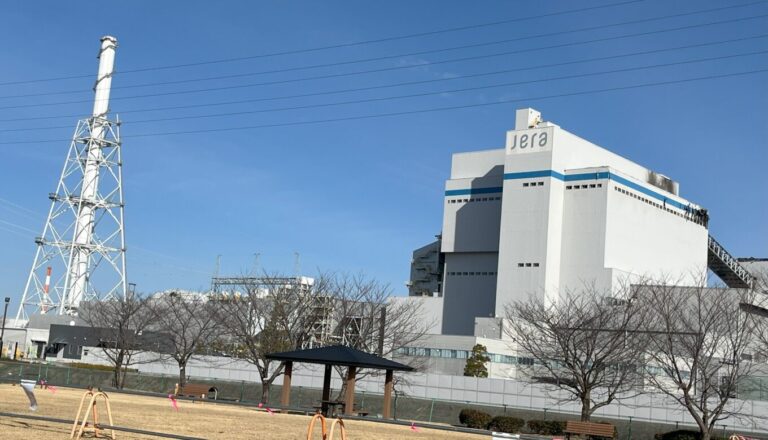On January 31, 2024, an explosion and subsequent fire occurred at JERA’s Taketoyo Thermal Power Station (Taketoyo, Aichi Prefecture) where woody biomass fuel was being temporarily stored. JERA has refused to explain the causes to residents and has remained quiet after establishing an accident investigation committee on February 5*.
*JERA released “On the Status of the Investigation into the Fire that Occurred on 31 January at Taketoyo Thermal Power Station” on March 21, but has not have any explanatory meeting to residents.
The Taketoyo Thermal Power Station, with an output capacity of 1,070 MW and co-firing woody biomass, is among the largest in Japan in terms of single unit output. The fire, which was observed near a bunker storing wood pellets at about 3:11 pm on January 31, spread over a conveyor belt connected from a bunker to a boiler. The fire was extinguished once at 8:04 pm on the same day, but reemerged in the vicinity of the belt conveyor at 2:40 am on February 1, believed to be caused by residual embers in wood fuel in the conveyor belt damaged by the first fire. The fire was extinguished again about an hour later at 3:34 am. In this accident, the wall of the boiler building where the fuel was burned was also damaged by the explosion. Taketoyo Thermal Power Station was shut down at 3:29 p.m. on January 31 in response to the fire.
General information on Taketoyo Thermal Power Station, Unit 5
Output capacity : 1,070MW
Power generation system : Ultra-supercritical (USC)
Fuel co-firing rate : coal and woody biomass fuel (wood pellet), co-firing rate is about 17% (calorific value)
Annual fuel volume : wood pellet approx. 500,000 tons / coal (for mixed-burning) approx. 2.4 million tons
Operation began: August, 2022
Estimated annual power generation : approx. 7.5 billion kWh
According to JERA, mixing approximately 2.4 million tons of coal with approximately 500,000 tons of wood pellets can reduce CO2 emissions by approximately 900,000 tons per year (compared to when coal is burned exclusively). However, the CO2 emissions from burning approximately 2.4 million tons of coal are enormous, and it is estimated that one unit would emit approximately 5.69 million tons of CO2 if the annual facility utilization rate were 80%.
In order to achieve the 1.5℃ target to avoid the worst impacts of climate change, it is necessary to cut greenhouse gas (GHG) emissions to net zero by 2050. While acknowledging that biomass co-firing can reduce some CO2 emissions of a coal-fired power plant, the Ministry of Environment has issued the Minister of the Environment’s Opinion about the CO2 emission amount of Taketoyo Thermal Power Station during its environmental impact assessment (EIA) process (Document on Primary Environmental Impact Consideration, and the Draft Environmental Impact Statement). Despite these opinions, in accordance with the energy policy under the Kishida administration, JERA began commercial operation of the plant on August 5, 2022, with media reporting that the plant is expected to contribute to Japan’s energy stability.
Since the fire, operations at the plant have been suspended, but according to the Agency for Natural Resources and Energy (ANRE), there appears to be no impact on the stable supply of electricity.
Fire accidents possibly caused by woody biomass
In response to the Taketoyo explosion, on February 1, the Ministry of Economy, Trade and Industry (METI) requested power utilities to conduct emergency inspections of the plants that use biomass fuel to check their facilities and take countermeasures. JERA announced it conducted inspections at Hekinan Thermal Power Station (Hekinan City, Aichi Prefecture) and Hitachinaka Thermal Power Station (Tokai-mura, Naka-gun, Ibaraki Prefecture), which use similar woody biomass fuel.
Although the accidents were not of the same scale as this one, there were two previous incidents at Taketoyo Thermal Power Station, as well as a number of accidents at biomass-fueled power plants operated by JERA and other utilities in recent years. Most of these accidents appeared to be caused by woody biomass.
| Date | Power Plant Name | Location | Operating Company |
| Sep. 2023 | Taketoyo Thermal Power Station | Taketoyo-cho, Chita-gun, Aichi | JERA |
| Sep. 2023 | Yonago Biomass Power Generation | Yonago-shi, Tottori | Chubu Electric Power |
| May 2023 | Yonago Biomass Power Generation | Yonago-shi, Tottori | Chubu Electric Power |
| Mar. 2023 | Maizuru Power Station | Maizuru, Kyoto | Kansai Electric Power |
| Jan. 2023 | Sodegaura Biomass Power Plant | Sodegaura, Chiba | Osaka Gas |
| Jan. 2023 | Taketoyo Thermal Power Station | Taketoyo-cho, Chita-gun, Aichi | JERA |
| Jan. 2023 | Shimonoseki Biomass Power Plant | Shimonoseki, Yamaguchi | Kyuden Mirai Energy, etc. |
| Sep. 2022 | Hitachinaka Power Station | Tokai-mura, Naka-gun, Ibaraki | JERA |
| Sep. 2022 | Taketoyo Thermal Power Station | Taketoyo-cho, Chita-gun, Aichi | JERA |
| Aug. 2022 | Taketoyo Thermal Power Station | Taketoyo-cho, Chita-gun, Aichi | JERA |
| Feb. 2022 | CEPO Handa Biomass Power | Handa, Aichi | Chubu Electric Power Group |
| Oct. 2020 | Hibikinada Biomass Power Station | Kitakyushu, Fukuoka | Hibikinada Energy Park |
We at Japan Beyond Coal call for JERA to investigate the cause of the Taketoyo Thermal Power Station fire accident and explain the cause, as well as to disclose the lifecycle CO2 emission reductions from co-firing woody biomass since the start of the unit’s operation.
Reference
【News】Taketoyo Unit 5 begins operation: What does this mean for Japan? (JBC News)

